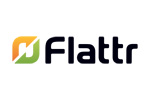Flattr moved out of beta testing and opened to the public today. The social micropayments platform is intended to allow Internet content providers to collect money for their content in the form of tips, or small payments made to demonstrate approval or enjoyment of the content.
With Flattr, users pay a monthly fee. Although there is a minimum of 2 euros, they can make the amount as large as they like. Users can then click a Flattr button on sites to show that they enjoyed the content. The button displays how many people have clicked it in order to make a donation. At the end of each month, the fee is divided among the creators of the websites that the user clicked. For consumers, this allows them to contribute financially to creators whose work they enjoy. For producers, this allows them to collect money from their readers. Flattr's revenue comes from taking 10% of the fees and says it may lower that percentage as the service becomes more successful.
Content producers can add a Flattr button to their site in three ways: by manually submitting the link on the Flattr site; through plug-ins, extensions and modules that include plug-ins for popular blogging platforms like MoveableType, Tumblr, and WordPress; or by using the FLattr API. You can add Flattr links on Facebook, Flickr, MySpace, Twitter, and YouTube.
Flattr says the product is aimed at "bloggers and their readers, musicians and their listeners, photographers, film creators, programmers, and so on." The name is a combination of the words "flatter" and "flat-rate."
The service is the creation of a group formerly associated with BitTorrent site The Pirate Bay , including Peter Sunde. WIkiLeaks announced at the beginning of the month that they would be using the Flattr service to fund their activities. Other users include German newspapers taz.de and der Freitag
Other companies offering a similar micropayment service include Kachingle and Rewrd .
[youtube]9zrMlEEWBgY[/youtube]

